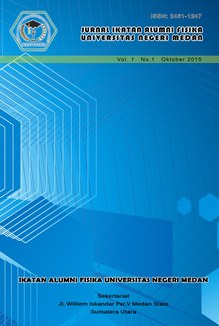PENGARUH MODEL PEMBELAJARAN MAKE A MATCH TERHADAP HASIL BELAJAR FISIKA SISWA MAN DOLOK MASIHUL SERDANG BEDAGAI TAHUN PELAJARAN 2014-2015
DOI:
https://doi.org/10.24114/jiaf.v1i1.2690Abstract
Penelitian ini bertujuan untuk mengetahui pengaruh model pembelajaran Make A Match terhadap hasil belajar fisika siswa MAN Dolok Masihul Tahun Pelajaran 2014/2015.Jenis penelitian ini adalah eksperimen dengan desain two group design pre-test dan post- test. Populasi dalam penelitian ini adalah seluruh siswa kelas X MAN Dolok Masihul yang terdiri dari 4 kelas. Pengambilan sampel dilakukan cara cluster random sampling dengan jumlah sampel penelitian 2 kelas yaitu X4 Dari analisa data diperoleh skor rata “ rata pretes kelas eksperimen sebesar 6,83 dengan standar deviasi adalah 1,64 dan nilai rata-rata kelas kontrol adalah 5,56 dan standar deviasi adalah 0,806.. Setelah pembelajaran selesai diberi nilai rata-rata postes kelas eksperimen sebesar 8,96 dengan standar deviasi 3,3 dan kelas kontrol sebesar 6,76 dan standar deviasi 2,9. Pada uji normalitas kelas eksperimen untuk postes diperoleh Lhitung Ë‚Ltabel = 0,1527Ë‚ 0,161 dan pada kelas kontrol = 0,1236 Ë‚ 0,161 maka kedua kelas tersebut memiliki data berdistribusi normal. Pada uji homogenitas data postes kedua sampel diperoleh FhitungË‚Ftabel = 1,3 Ë‚ 1,65 maka kedua sampel berasal dari sampel yang homogen. Hasil uji t diperoleh thitung >ttabel = 2,97 > 1,671 sehingga penelitiannya ada pengaruh model pembelajaran make a match terhadap hasil belajar fisika siswa MAN Dolok Masihul Tahun Pelajaran 2014/2015.Downloads
Published
2015-10-26
Issue
Section
Articles
License
Authors who publish with this journal agree to the following terms:- Authors retain copyright and grant the journal right of first publication with the work simultaneously licensed under a Creative Commons Attribution License that allows others to share the work with an acknowledgement of the work's authorship and initial publication in this journal.
- Authors are able to enter into separate, additional contractual arrangements for the non-exclusive distribution of the journal's published version of the work (e.g., post it to an institutional repository or publish it in a book), with an acknowledgement of its initial publication in this journal.
- Authors are permitted and encouraged to post their work online (e.g., in institutional repositories or on their website) prior to and during the submission process, as it can lead to productive exchanges, as well as earlier and greater citation of published work (See The Effect of Open Access).

